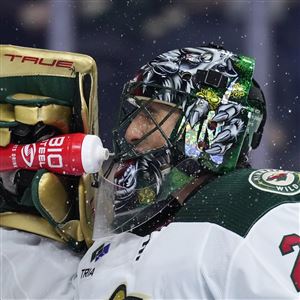NEWARK, N.J. — The Penguins in Tuesday’s 5-1 loss to the New Jersey Devils were reminded of the difference a premium pickup can make when they watched Timo Meier tap in the power play goal that seemed to break their spirit.
Meier, one of the top players to change teams prior to last month’s trade deadline, didn’t have to do much to score that goal. But at least he did something.
Too often Pittsburgh has not been able to say the same about Mikael Granlund, the forward acquired from Nashville in exchange for a second-round pick.
Before the previous two deadlines, general manager Ron Hextall bolstered the team’s Stanley Cup chances by bringing in Jeff Carter and Rickard Rakell.
Carter in 2021 made a bigger impact than even the Penguins could have hoped, scoring 13 goals in 20 games, including the playoffs. The decision to re-sign him has proven to be a costly mistake, but this guy was great initially.
One year later, Hextall gave up a second-round pick and a solid prospect, goalie Calle Clang, to acquire Rakell. His contributions were more subtle, but he had 13 points and a plus-7 rating in his first 19 games in Pittsburgh. Re-signed, Rakell is within striking distance of a 30-goal season in 2022-23.
So far this spring, Pittsburgh has gotten much less from Granlund, whom Hextall acquired after an unsuccessful push to land Vancouver’s J.T. Miller.
The loss in New Jersey was Granlund’s 17th game since the trade. He drilled the post late in the second period, when the Penguins were theoretically still in it. But he was again held without a point. His last goal was on March 11.
The former top-10 pick has just four points in 17 games. Carter, Brian Dumoulin and Pierre-Olivier Joseph have produced more than Granlund since his first game on March 2. Ryan Poehling and Josh Archibald netted more goals.
Mike Sullivan acknowledged Granlund has not made much of a dent offensively. But he thinks Granlund, who is playing fewer minutes and in a different role than in Nashville, has been more helpful than the box score indicates.
“He certainly makes us deeper. He’s a good player,” he said. “He’s conscientious defensively. He helps us in that regard. We’ve used him on the second power play. We think he’s a pretty good playmaker. He sees the ice pretty well.”
Granlund arrived in Pittsburgh with a reputation of a pass-happy distributor, not a big-time scorer. Watch him play a few shifts and you do notice he has a unique style, a blend of patience and shiftiness, which has yet to translate.
He has fired just 32 shots on goal in 17 games. That is actually a higher per-game rate than he had in each of his final three seasons with the Predators. Instead, his first instinct — and often the second and the third — is to hang o nto the puck, draw a defender toward him then dish it to the open teammate.
That approach worked in previous spots. Look no further than Jason Zucker, who while with the Minnesota Wild scored 30 goals with a Granlund assist. He noted how Granlund’s way of making plays differs from, say, Evgeni Malkin.
“Granny is a guy that waits. He waits for the defender to make a move and then passes it to where he’s not. Whereas Geno is a guy that just passes through people,” he said. “There’s two completely different ways of passing pucks.”
Zucker said Granlund’s linemates, presently Poehling and Danton Heinen, have to be patient, too. They must pop into open ice when a defender bites.
Thus far, Granlund has had difficulty connecting with his new teammates. He has completed just 56.8% of his passes in the offensive zone at 5-on-5, per Sportlogiq. That is 13th among Penguins forwards since he joined the team.
Granlund does slide nearly one pass per game to somebody in the slot, one of the team’s better rates. But so far he has dished out just one primary assist — and that was on Poehling’s empty-netter in Sunday’s win over Philadelphia.
He recently acknowledged he was still getting a feel for his new teammates.
“As the time goes on, you start to learn the tendencies of the guys on the ice and everything gets a little bit quicker and gets a little bit easier,” he said.
As a scoring threat, he ranks outside the top eight among Penguins forwards since the trade in individual expected goals, total shot attempts and scoring chances, per Sportlogiq. One area where he has earned good looks is off the rush.
“Hopefully, I can produce some more,” said Granlund, who had 36 points in 58 games with Nashville. “But I’m pretty happy with my game, to be honest.”
Buoying Granlund and his lines has been solid defensive work to date. It’s not all him, but opponents have scored just seven times with him on at 5-on-5.
His individual defensive impacts have been quite good. Since March 2, he leads all Penguins forwards in blocked shots per game. He has broken up passes in the defensive zone at a decent clip. And he is fifth in puck battles won.
“He’s a really good defensive player,” Zucker said. “He anticipates plays. He knows what the offensive guys want to do because he thinks the same way.”
Zooming out to a team level, the Penguins have a rate of expected goals against of 2.24 per 60 minutes with Granlund on at 5-on-5, according to Natural Stat Trick. Small sample, sure, and the caliber of his competition is lesser. But that is not far off from Selke favorites Patrice Bergeron and Mikael Backlund.
As a result, Sullivan has trusted Granlund to take on a sizable share of defensive zone starts and some late-game shifts. He’s a penalty-kill regular, too.
But given the cost to get him from the Predators and his $5 million salary, which is on the books for another two seasons, the Penguins need him to be more than a Teddy Blueger type. Granlund must spark some scoring — and fast.
The season is slipping away. Time for Granlund to start making a difference.
Matt Vensel: mvensel@post-gazette.com and Twitter @mattvensel.
First Published: April 5, 2023, 2:32 p.m.



















